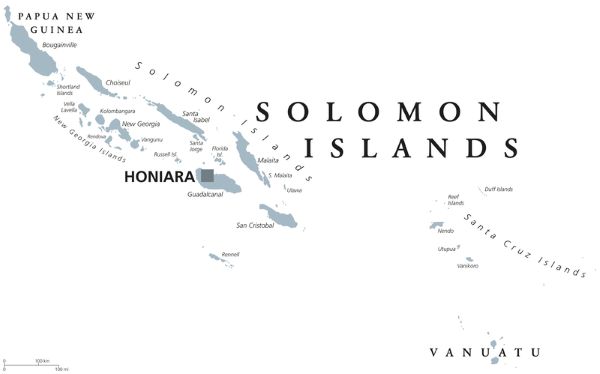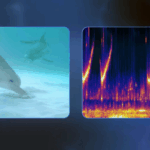As global warming causes oceans to rise and extreme weather events produce higher than normal tides, a Solomon Island community, Walande, is vanishing. In a 2022 article published by NSF, the U.S. National Science Foundation, the islands of the Pacific are described as “the front line in the battle against climate change,” a battle island nations are losing.
The Pacific Ocean contains 25,000 islands with their territorial waters and land covering 15% of the planet’s surface. Many of these islands lie atop coral reefs. They are called atolls and stand on average no more than a metre or two above sea level. At these heights, storm waves and high tides can overwhelm the land, saturate the soils with saltwater, and contaminate freshwater surface and underground sources.
Even when measured in centimetres per decade, sea level rise represents an existential threat. Add atmospheric and ocean heating, and the periodicity of El Niño–Southern Oscillations (ENSO) to the mix, and the future of these island communities surviving is dire. Climatologists’ forecasts show Pacific Ocean sea levels rising between 25 and 58 centimetres (10 inches to nearly two feet) by 2050.
For the island nations of Fiji, Kiribati, Palau, Vanuatu, Tuvalu, the Marshall and Solomon Islands, sea level rise and extreme tides and weather events are forcing communities to relocate. Walande’s former island home is gone. Its 800 residents now live on Malaita, one of the six main islands in the 900-plus that are part of the Solomon Islands nation. The story of Walande has been captured in a video. The community now resides on 18.6 hectares (46 acres) of higher ground. For World War Two buffs, better known Solomon islands include Guadalcanal and New Georgia, where the Americans and Japanese clashed.
In 2022, the Solomon Islands’ government published “Planned Relocation Guidelines” to ensure communities facing sea level rise would have new homes, and retain living standards and their community culture. Although the guidelines have yet to be fully adhered to, nonetheless, Walande has found a new home.
Joining the Solomon Islands with formal relocation guidelines are Fiji, Vanuatu, and Kiribati. The Marshall Islands and Tuvalu, although facing the threat of rising sea levels, have yet to establish guidelines.
Tuvalu’s approach has been to arrange with the New Zealand government a managed migration strategy to allow the entire nation to relocate to the latter.
The Marshall Islands government has no formal plan other than to stay and fight the rising Pacific. The nation has a Compact of Free Association with the United States that allows Marshallese to live and work in America without a visa. It is not a full-out migration, but one done in drips and drabs.
What is the status of sea level rise for other Pacific island nations other than the Solomon Islands? The Pacific is experiencing accelerated sea level rise. In 2024, the surge amounted to 0.59 centimetres, with 3.9 millimetres attributed to ocean warming causing thermal expansion and accelerated melting of Antarctica and Greenland contributing to the rise of the Pacific.
For Tuvalu with a mean elevation of 1.5 metres above sea level, and Kiribati at 2 metres above sea level, the rise in the Pacific is 3 to 4 times faster than the global average, largely attributed to El Niños and ocean heat uptake. The two island nations, along with Fiji, expect a 15 centimetre (6 inch) sea level rise by 2050.
Already, the Solomon Islands have seen five islands disappear with six of its larger islands shrinking by more than 20%. Palau has watched a third of its coral reefs vanish.
What about the islands of Hawai’i? Are they equally vulnerable? Not so much since all of the islands are volcanic in origin rather than built up on coral reefs. That doesn’t mean Hawai’i will escape sea level rise predicted to be in the medium range between 0.15 metres (0.7 feet) and 0.45 metres (1.5 feet) higher by 2050. For Hawai’i, the damage will come from higher tides, coastal flooding and saltwater intrusion into freshwater sources and extreme weather events.
Archeological studies of Pacific Ocean island populations in the past indicate sea level changes have had dramatic impacts on their societies. The islands were first populated by South Asian migrants travelling thousands of kilometres across the ocean, island hopping one at a time. These people were fishers and foragers who took advantage of the abundant life around the coral atolls and inland. The archeological record shows a pattern of civilization rise and fall linked to sea level changes. Initial colonization appears to have coincided with a cooler period in the Pacific with sea levels dropping by as much as 2 metres (6.6 feet) between 4,000 and 1,200 years ago. A similar cooling around 1300 AD, however, harmed Pacific island native cultures with the abandonment of shoreline settlements. Why? Rapid sea level falls caused freshwater tables to drop, negatively impacted seawater circulation within the island’s atolls and reefs, and caused massive die-offs. The competition to survive is seen in warlike evidence in the archeological record as food and resource abundance turned into scarcity.
What can we conclude from the archeological record? Pacific island nations have been dramatically impacted by sea level change in the past and are once again undergoing the existential stresses that come with it in the present. The tragedy is that 25 Pacific island nations that contribute a mere 0.06% of the greenhouse gasses responsible for global warming and sea level rise will vanish, while those remaining on the islands will see water supplies, food production and fisheries all negatively impacted.









